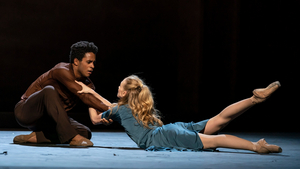Review: DANCES AT A GATHERING / THE CELLIST, ROH Live

![]() Covent Garden's Royal Opera House continues its successful series of live screenings to over 1000 cinemas across the world. Dances at a Gathering / The Cellist is a chance to see two incredibly different ballets in one evening; both beautifully moving in their own ways.
Covent Garden's Royal Opera House continues its successful series of live screenings to over 1000 cinemas across the world. Dances at a Gathering / The Cellist is a chance to see two incredibly different ballets in one evening; both beautifully moving in their own ways.
In a reversal of the previous showings, we start the evening with Jerome Robbins' Dances at a Gathering. Having been danced since 1970, the performance has no storyline at all, but it is difficult not to project interpretations onto the ten dancers performing a series of short scenarios set to music by Chopin.
Alexander Campbell is full of vim and vigour and Francesca Hayward has steps as light as air. The performance has no set or props, the background is warmly lit and the dancers appear in calming pastel tones; it is simply a joyful celebration of dance.
It is also a highly technical piece, with nowhere for the dancers to hide. There is a sense of great freedom of movement, but also incredible precision. Robert Clark accompanies beautifully throughout on a solo piano; there is great collaboration between the dancers and pianist and the result is fantastic synergy and physical reflection of the music.
The second half of the evening is the debut work for the Royal Opera House by British choreographer Cathy Marston. The Cellist is a sensitive, if overly busy, celebration of celebrated musician Jacqueline du Pré. du Pré was a child prodigy who became the most talented cellist of her generation and was tragically forced to give up concert playing at the age of 28 after developing multiple sclerosis.
du Pré had two great loves in her life; her husband, the Argentine pianist Daniel Berenboim and her Stradivarius cello.
A clever part of this ballet is the use of a dancer as a living interpretation of the cello itself. The Instrument, as it is known, is danced by the fantastic Marcelino Sambé, who is surely becoming one of the company's most exciting Principals. Sambé uses his body in a multitude of curling movements to suggest the shape of the cello an conveys deep love and affection for du Pré. He reacts beautifully to her and her moods, animating and elevating her as she becomes immersed in the music.
As the cello, the male dancer is placed in front of the female and so the intimacy between du Pré and her instrument is clear from the start. Lauren Cuthbertson takes the title role and is wonderfully adept at conveying the wide range of emotions, from passionate love for her husband to her decline into illness. This decline is shown with great sensitivity and compassion, from an initial gentle trembling in Cuthbertson's leg to the abject cruelty of her inability to play any longer. The tragedy is clear, but never strays into sentimentality.
There is intense chemistry between Cuthbertson and Sambé, with intensely joyful duets; so much so that it is a constant presence within the relationship between du Pré and Barenboim, known as The Conductor. Danced by a darkly charismatic Matthew Ball, his pas de deux with Cuthbertson is passionate and sensual. However, it is clear that this is a relationship between three, as the trio dance evocatively together, entwined and entangled.
The ballet is sensitive and ambitious, but at over an hour it is too long and needs editing. There is also too much use of the corps de ballet, who are used to convey everything from musical friends to a chorus of narrators. It feels too busy and unexplained at points.
Philip Feeney's score cleverly combined his own music with excerpts from some of the music most associated with du Pré, particularly Elgar's Cello Concerto, played with poise and great emotion by the talented Hetty Snell.
Hildegard Bechtler's brutalist set gives the impression of being inside the cello, with curved lines and strips of light.
Despite the sadness woven into the bones of this piece, it feels like a suitable, if overly long, celebration of du Pré's talent.
Directed for the screen by former ballet dancer Ross MacGibbon, both performances translate very well onto the big screen. The lack of any set of Dances at a Gathering and the stark minimalism of the set of The Cellist means all the focus can be on the dancers, without losing any appreciation of the overall look. There are lots of tight closeups, giving a real sense of the dancers' efforts. There are also atmospheric, soaring shots of the fabulous Royal Opera House interior.
These two ballets are an excellent combination to be shown in the same evening; the audience has the opportunity to experience a wide range of emotions and also witness some incredible dancing.
The Cellist / Dances At A Gathering is encoring in cinemas on 1 March
Photo Credit: Bill Cooper
Reader Reviews
Videos


